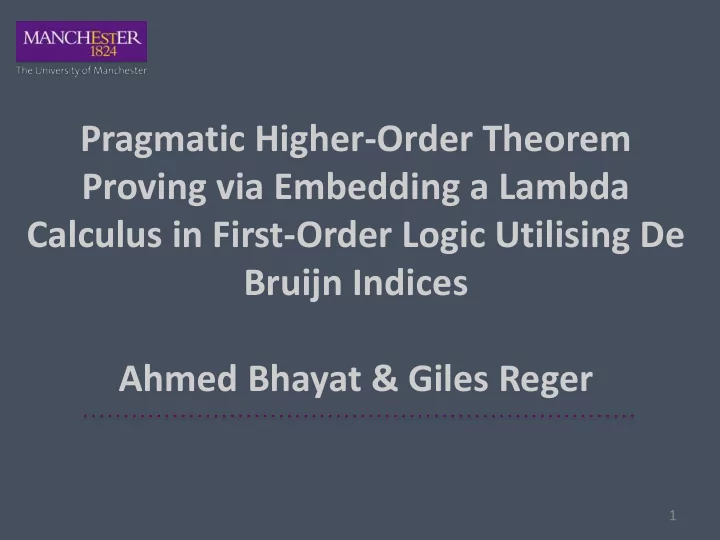

Pragmatic Higher-Order Theorem Proving via Embedding a Lambda Calculus in First-Order Logic Utilising De Bruijn Indices Ahmed Bhayat & Giles Reger 1
Outline Of Presentation 1. ‘ Standard ’ translation from higher-order to first- order logic (implemented) 2. Eta-long form translation (ongoing) 3. Deduction Modulo (future work, tying together (1) and (2)) 2
The Vampire Prover • Modern, award-winning saturation based, first-order theorem prover • Implements a resolution and superposition calculus • Track record of modifiability 3
Vampire Higher-Order • Project started roughly nine-month ago • Vampire already being run as back-end to interactive provers • Why not develop translation module? – In control of translation – Aware of axioms – Can easily modify inference rules 4
Applicative Translation More or less ‘ standard ’ : • Lambda functions translated using combinators • Application translated using binary app function • Higher-order logical constants and combinators axiomatised 5
Applicative Translation Drawbacks: • Structure of original lost • Head symbol deeply embedded • Apps and combinators can clog up data structures • Translation is incomplete. No way to prove: • Can we do better? 6
De Bruijn Indices • A nameless version of the lambda-calculus • Lambda is no longer a binder. Can be treated as a unary function • Indices can be treated as first-order constants • Partial application: – Use two place app – Store all terms in eta-long form ✓ 7
De Bruijn Translation • Higher-order variables remain • Allow them to remain and update provers structures and algorithms to deal with them • Not obvious how to update superposition – Developing simplification orders in the presence of lambdas is a challenge 8
Pragmatism • Block superposition from being carried out on terms containing higher-order variables • Rely on resolution • To be complete, unification must be modulo beta and eta-reduction • Higher-order unification – Semi-decidable – Generates complete sets of unifiers, prolific 9
Pragmatism (2) • Unify a sub-class of terms • Candidate unification algorithms: – Pattern unification – Prefix unification • Perhaps implementing these unification algorithms is sufficient to prove a large class of interesting problems? 10
Prefix Unification • Unify higher-order variable with prefix term which has same type ✓ • Prefix unification is decidable • Most general unifiers exist 11
Prefix Unification • Vampire uses substitution tree for matching and unification • All children of a node bind one special variable • Bound terms stored in order of head symbol 12
Solution • Store terms in ‘ buckets ’ based on type of head symbol • Each node stores a list of buckets • Buckets for node 13
Solution • Query term has variable head: – Return all terms with same or larger type in relevant bucket 14
Solution • Query term has rigid head: – Return all flexible terms with same or smaller type in relevant bucket 15
Future Work • What is the bigger picture? • Treat higher-order logic as a first-order theory • Various axiomatisations possible (Dowek, 2008) – With combinators – With De Bruijn indices and explicit substitutions • Axiomatisations can lead to non-goal directed search 16
Deduction Modulo • Dowek et al. (2003) introduced deduction modulo • Treat axioms of theory as rewrite rules – Term rewrite rules: – Propositional rewrite rules: 17
Deduction Modulo • Resolution now becomes resolution modulo • Carry unification constraints • Unification is modulo set of equations • Introduce new inference rule extended narrowing 18
Deduction Modulo • Resolution modulo is a complete proof method for any theory that has cut-elimination property • There has been further work on resolution modulo: – Polarised resolution modulo – Ordered polarised resolution modulo • Some strong results for the latter – The rewrite rules do not need to be compatible with the ordering relationship 19
Ordered Polarised Resolution Modulo • Create polarity aware rewrite rules • No need for clausification • Add ordering restrictions to One-way clause deduction modulo representing rule: • Still complete 20
In Practice • At least two practical attempts at implementation: – iProver modulo – Zenon modulo • Both showed some promise • Many questions, theoretical and practical remain 21
Open Questions • Can there be a superposition modulo complete for all theories that enjoy cut-elimination? • If yes, can the independence between the rewrite rules and be maintained? • How to recognise unsatisfiable constraints? • Indexing data structures for unification modulo? 22
Superposition Modulo? • Normal completeness proof relies on saturation of clause set with respect to • One-way clauses would have to be saturated as well • This creates a dependency between the rewrite system and the ordering • Is this necessary? 23
Deduction Modulo and Higher-Order Logic • Both axiomatisation of higher-order logic enjoy cut- elimination • With combinators unification is modulo: 24
Deduction Modulo and Higher-Order Logic • With De Bruijn indices and explicit substitutions unification is modulo the rules of the • Both unification algorithms have been studied • Both are semi-decidable An idea: • Run unification algorithm to some depth • If small complete set of unifiers returned, apply unifiers • Otherwise leave as constraint on clause 25
Further Thoughts • Is the best explicit substitution calculus for the purpose? • How to update Vampire ’ s highly optimised term structure without harming performance? • Can substitution trees be updated to handle unification modulo the rewrite rules of either translation? 26
Questions ? 27
Recommend
More recommend